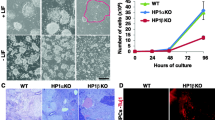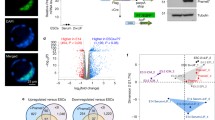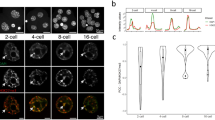Abstract
Epiblast stem cells (EpiSCs), which are pluripotent cells isolated from early post-implantation mouse embryos (E5.5), show both similarities and differences compared to mouse embryonic stem cells (mESCs), isolated earlier from the inner cell mass (ICM) of the E3.5 embryo. Previously, we have observed that while chromatin is very dispersed in E3.5 ICM, compact chromatin domains and chromocentres appear in E5.5 epiblasts after embryo implantation. Given that the observed chromatin re-organization in E5.5 epiblasts coincides with an increase in DNA methylation, in this study, we aimed to examine the role of DNA methylation in chromatin re-organization during the in vitro conversion of ESCs to EpiSCs. The requirement for DNA methylation was determined by converting both wild-type and DNA methylation-deficient ESCs to EpiSCs, followed by structural analysis with electron spectroscopic imaging (ESI). We show that the chromatin re-organization which occurs in vivo can be re-capitulated in vitro during the ESC to EpiSC conversion. Indeed, after 7 days in EpiSC media, compact chromatin domains begin to appear throughout the nuclear volume, creating a chromatin organization similar to E5 epiblasts and embryo-derived EpiSCs. Our data demonstrate that DNA methylation is dispensable for this global chromatin re-organization but required for the compaction of pericentromeric chromatin into chromocentres.



Similar content being viewed by others
References
Ahmed K, Dehghani H, Rugg-Gunn P et al (2010) Global chromatin architecture reflects pluripotency and lineage commitment in the early mouse embryo. PLoS One 5:e10531. doi:10.1371/journal.pone.0010531
Ahmed K, Li R, Bazett-Jones DP (2009) Electron spectroscopic imaging of the nuclear landscape. Methods Mol Biol 464:415–423. doi:10.1007/978-1-60327-461-6_23
Almouzni G, Probst AV (2011) Heterochromatin maintenance and establishment: lessons from the mouse pericentromere. Nucleus 2:332–338. doi:10.4161/nucl.2.5.17707
Auclair G, Guibert S, Bender A, Weber M (2014) Ontogeny of CpG island methylation and specificity of DNMT3 methyltransferases during embryonic development in the mouse. Genome Biol 15:545–560. doi:10.1186/s13059-014-0545-5
Auclair G, Weber M (2012) Mechanisms of DNA methylation and demethylation in mammals. Biochimie 94:2202–2211. doi:10.1016/j.biochi.2012.05.016
Bao S, Tang F, Li X et al (2009) Epigenetic reversion of post-implantation epiblast to pluripotent embryonic stem cells. Nature 461:1292–1295. doi:10.1038/nature08534
Bazett-Jones DP, Hendzel MJ (1999) Electron spectroscopic imaging of chromatin. Methods 17:188–200. doi:10.1006/meth.1998.0729
Bazett-Jones DP, Li R, Fussner E et al (2008) Elucidating chromatin and nuclear domain architecture with electron spectroscopic imaging. Chromosom Res 16:397–412. doi:10.1007/s10577-008-1237-3
Bertulat B, De Bonis ML, Della Ragione F et al (2012) MeCP2 dependent heterochromatin reorganization during neural differentiation of a novel Mecp2-deficient embryonic stem cell reporter line. PLoS One 7:e47848. doi:10.1371/journal.pone.0047848
Bestor T, Laudano A, Mattaliano R, Ingram V (1988) Cloning and sequencing of a cDNA encoding DNA methyltransferase of mouse cells: the carboxyl-terminal domain of the mammalian enzymes is related to bacterial restriction methyltransferases. J Mol Biol 203:971–983
Borgel J, Guibert S, Li Y et al (2010) Targets and dynamics of promoter DNA methylation during early mouse development. Nat Genet 42:1093–1100. doi:10.1038/ng.708
Brero A, Easwaran HP, Nowak D et al (2005) Methyl CpG-binding proteins induce large-scale chromatin reorganization during terminal differentiation. J Cell Biol 169:733–743. doi:10.1083/jcb.200502062
Brons IG, Smithers LE, Trotter MW et al (2007) Derivation of pluripotent epiblast stem cells from mammalian embryos. Nature 448:191–195. doi:10.1038/nature05950
Della Ragione F, Vacca M, Fioriniello S et al (2016) MECP2, a multi-talented modulator of chromatin architecture. Brief Funct Genomics 15:420–431. doi:10.1093/bfgp/elw023
Dellaire G, Nisman R, Bazett-Jones DP (2004) Correlative light and electron spectroscopic imaging of chromatin in situ. Methods Enzymol 375:456–478
Even-Faitelson L, Hassan-Zadeh V, Baghestani Z, Bazett-Jones DP (2016) Coming to terms with chromatin structure. Chromosoma 125:95–110. doi:10.1007/s00412-015-0534-9
Fussner E, Ahmed K, Dehghani H et al (2010) Changes in chromatin fiber density as a marker for pluripotency. Cold Spring Harb Symp Quant Biol 75:245–249. doi:10.1101/sqb.2010.75.012
Fussner E, Djuric U, Strauss M et al (2011) Constitutive heterochromatin reorganization during somatic cell reprogramming. EMBO J 30:1778–1789. doi:10.1038/emboj.2011.96
Georgel PT, Horowitz-Scherer RA, Adkins N et al (2003) Chromatin compaction by human MeCP2 assembly of novel secondary chromatin structures in the absence of DNA methylation. J Biol Chem 278:32181–32188. doi:10.1074/jbc.M305308200
Gilbert N, Thomson I, Boyle S et al (2007) DNA methylation affects nuclear organization, histone modifications, and linker histone binding but not chromatin compaction. J Cell Biol 177:401–411. doi:10.1083/jcb.200607133
Guenatri M, Bailly D, Maison C, Almouzni G (2004) Mouse centric and pericentric satellite repeats form distinct functional heterochromatin. J Cell Biol 166:493–505. doi:10.1083/jcb.200403109
Habibi E, Brinkman AB, Arand J et al (2013) Whole-genome bisulfite sequencing of two distinct interconvertible DNA methylomes of mouse embryonic stem cells. Cell Stem Cell 13:360–369. doi:10.1016/j.stem.2013.06.002
Hsieh CL (1999) In vivo activity of murine de novo methyltransferases, Dnmt3a and Dnmt3b. Mol Cell Biol 19:8211–8218
Jackson M, Krassowska A, Gilbert N et al (2004) Severe global DNA hypomethylation blocks differentiation and induces histone hyperacetylation in embryonic stem cells. Mol Cell Biol 24:8862–8871. doi:10.1128/MCB.24.20.8862-8871.2004
Jouneau A, Ciaudo C, Sismeiro O et al (2012) Naive and primed murine pluripotent stem cells have distinct miRNA expression profiles. RNA 18:253–264. doi:10.1261/rna.028878.111
Kafri T, Ariel M, Brandeis M et al (1992) Developmental pattern of gene-specific DNA methylation in the mouse embryo and germ line. Genes Dev 6:705–714
Lachner M, O’Carroll D, Rea S et al (2001) Methylation of histone H3 lysine 9 creates a binding site for HP1 proteins. Nature 410:116–120. doi:10.1038/35065132
Lehnertz B, Ueda Y, Derijck AA et al (2003) Suv39h-mediated histone H3 lysine 9 methylation directs DNA methylation to major satellite repeats at pericentric heterochromatin. Curr Biol 13:1192–1200
Lei H, Oh SP, Okano M et al (1996) De novo DNA cytosine methyltransferase activities in mouse embryonic stem cells. Development 122:3195–3205
Leonhardt H, Page AW, Weier HU, Bestor TH (1992) A targeting sequence directs DNA methyltransferase to sites of DNA replication in mammalian nuclei. Cell 71:865–873
Li E, Bestor TH, Jaenisch R (1992) Targeted mutation of the DNA methyltransferase gene results in embryonic lethality. Cell 69:915–926
Maison C, Bailly D, Peters AH et al (2002) Higher-order structure in pericentric heterochromatin involves a distinct pattern of histone modification and an RNA component. Nat Genet 30:329–334. doi:10.1038/ng843
Martens JH, O’Sullivan RJ, Braunschweig U et al (2005) The profile of repeat-associated histone lysine methylation states in the mouse epigenome. EMBO J 24:800–812. doi:10.1038/sj.emboj.7600545
Murtha M, Strino F, Tokcaer-Keskin Z et al (2015) Comparative FAIRE-Seq analysis reveals distinguishing features of the chromatin structure of ground state-and primed pluripotent cells. Stem Cells 33:378–391. doi:10.1002/stem.1871
Nan X, Tate P, Li E, Bird A (1996) DNA methylation specifies chromosomal localization of MeCP2. Mol Cell Biol 16:414–421
Nikitina T, Ghosh RP, Horowitz-Scherer RA et al (2007a) MeCP2-chromatin interactions include the formation of chromatosome-like structures and are altered in mutations causing Rett syndrome. J Biol Chem 282:28237–28245. doi:10.1074/jbc.M704304200
Nikitina T, Shi X, Ghosh RP et al (2007b) Multiple modes of interaction between the methylated DNA binding protein MeCP2 and chromatin. Mol Cell Biol 27:864–877. doi:10.1128/MCB.01593-06
Niwa H, Burdon T, Chambers I, Smith A (1998) Self-renewal of pluripotent embryonic stem cells is mediated via activation of STAT3. Genes Dev 12:2048–2060
Novo CL, Tang C, Ahmed K et al (2016) The pluripotency factor Nanog regulates pericentromeric heterochromatin organization in mouse embryonic stem cells. Genes Dev 30:1101–1115. doi:10.1101/gad.275685.115
Okano M, Bell DW, Haber DA, Li E (1999) DNA methyltransferases Dnmt3a and Dnmt3b are essential for de novo methylation and mammalian development. Cell 99:247–257
Okano M, Xie S, Li E (1998) Cloning and characterization of a family of novel mammalian DNA (cytosine-5) methyltransferases. Nat Genet 19:219–220. doi:10.1038/890
Peters AH, Kubicek S, Mechtler K et al (2003) Partitioning and plasticity of repressive histone methylation states in mammalian chromatin. Mol Cell 12:1577–1589
Pradhan S, Bacolla A, Wells RD, Roberts RJ (1999) Recombinant human DNA (cytosine-5) methyltransferase. I. Expression, purification, and comparison of de novo and maintenance methylation. J Biol Chem 274:33002–33010
Rapkin LM, Ahmed K, Dulev S et al (2015) The histone chaperone DAXX maintains the structural organization of heterochromatin domains. Epigenetics Chromatin 8:44–58. doi:10.1186/s13072-015-0036-2
Saksouk N, Barth TK, Ziegler-Birling C et al (2014) Redundant mechanisms to form silent chromatin at pericentromeric regions rely on BEND3 and DNA methylation. Mol Cell 56:580–594. doi:10.1016/j.molcel.2014.10.001
Schotta G, Lachner M, Sarma K et al (2004) A silencing pathway to induce H3-K9 and H4-K20 trimethylation at constitutive heterochromatin. Genes Dev 18:1251–1262. doi:10.1101/gad.300704
Senner CE, Krueger F, Oxley D et al (2012) DNA methylation profiles define stem cell identity and reveal a tight embryonic-extraembryonic lineage boundary. Stem Cells 30:2732–2745. doi:10.1002/stem.1249
Smith ZD, Chan MM, Mikkelsen TS et al (2012) A unique regulatory phase of DNA methylation in the early mammalian embryo. Nature 484:339–344. doi:10.1038/nature10960
Smith ZD, Meissner A (2013) DNA methylation: roles in mammalian development. Nat Rev Genet 14:204–220. doi:10.1038/nrg3354
Sun B, Ito M, Mendjan S et al (2012) Status of genomic imprinting in epigenetically distinct pluripotent stem cells. Stem Cells 30:161–168. doi:10.1002/stem.793
Tesar PJ, Chenoweth JG, Brook FA et al (2007) New cell lines from mouse epiblast share defining features with human embryonic stem cells. Nature 448:196–199. doi:10.1038/nature05972
Tsumura A, Hayakawa T, Kumaki Y et al (2006) Maintenance of self-renewal ability of mouse embryonic stem cells in the absence of DNA methyltransferases Dnmt1, Dnmt3a and Dnmt3b. Genes Cells 11:805–814. doi:10.1111/j.1365-2443.2006.00984.x
Veillard AC, Marks H, Bernardo AS et al (2014) Stable methylation at promoters distinguishes epiblast stem cells from embryonic stem cells and the in vivo epiblasts. Stem Cells Dev 23:2014–2029. doi:10.1089/scd.2013.0639
Williams RL, Hilton DJ, Pease S et al (1988) Myeloid leukaemia inhibitory factor maintains the developmental potential of embryonic stem cells. Nature 336:684–687. doi:10.1038/336684a0
Acknowledgements
We thank Ren Li for assistance in preparing the sections for correlative fluorescence and electron spectroscopic imaging. The research was supported by the Canadian Institutes of Health Research. DPB-J holds the Canada Research Chair in Molecular and Cellular Imaging.
Author contribution
VH-Z helped design, carried out the experiments, helped to analyse the data, and wrote the paper. PR-G developed the method to convert ESCs to EpiSCs, provided data on converted EpiSCs, and helped to write the paper. DPB-J helped design the experiments, helped to analyse the data, and helped to write the paper.
Author information
Authors and Affiliations
Corresponding author
Ethics declarations
This article does not contain any studies with human participants or animals performed by any of the authors.
Conflict of interest
The authors declare that they have no conflict of interest.
Funding
The funding received was the Operating Grant number 229881 from the Canadian Institutes of Health Research.
Availability of data and materials
The datasets supporting the conclusions of this article are included within the article.
Electronic supplementary material
Supplementary Table S1
Primer sequences used for gene expression analysis (DOCX 15 kb)
Fig. S1
The average cluster sizes in WT and DNA methylation-deficient ESC and ESC-derived EpiSCs. The average cluster size in WT, DKO and TKO ESC-derived EpiSCs are 8,702, 9,421 and 10,009 nm2 respectively. These values are five to six times that observed in WT and DNA methylation-deficient ESCs. Using a t-test, the statistical significance of the greater than 5-fold increase in the cluster size distribution of the EpiSCs compared to the corresponding ESC lines is represented by a p-value of 0.0001 (DOCX 46 kb)
Fig. S2
The number of characteristic chromocentres is significantly reduced in TKO ESC-derived EpiSCs. The number of H3K9me3-enriched foci with characteristic chromocentre morphology (red bars) and dispersed chromatin (blue bars) in WT and TKO ESC-derived EpiSCs is displayed. The chi-square test shows that the difference in chromocentre morphology between WT and TKO ESC-derived EpiSCs is highly significant (χ2 =30.59, df=1, p-value<0.005) (DOCX 17 kb)
Rights and permissions
About this article
Cite this article
Hassan-Zadeh, V., Rugg-Gunn, P. & Bazett-Jones, D.P. DNA methylation is dispensable for changes in global chromatin architecture but required for chromocentre formation in early stem cell differentiation. Chromosoma 126, 605–614 (2017). https://doi.org/10.1007/s00412-017-0625-x
Received:
Revised:
Accepted:
Published:
Issue Date:
DOI: https://doi.org/10.1007/s00412-017-0625-x




